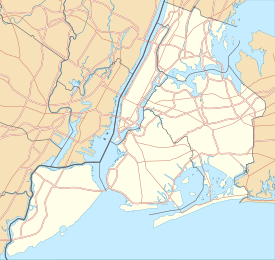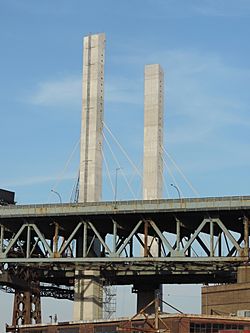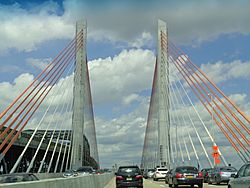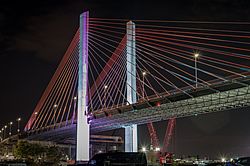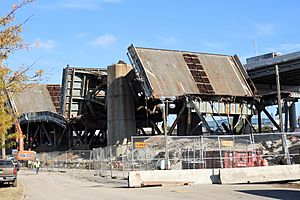Kosciuszko Bridge facts for kids
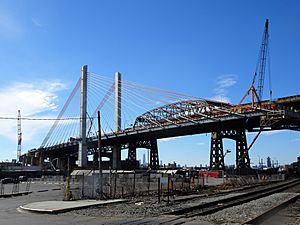
The Kosciuszko Bridge is a modern bridge in New York City. It crosses over Newtown Creek, connecting Greenpoint in Brooklyn to Maspeth in Queens. This bridge is actually made of two separate cable-stayed bridge spans. The first span, for eastbound traffic, opened in April 2017. The second span, for westbound traffic, opened in August 2019.
Before these new bridges, an older bridge with the same name stood in its place. This old bridge was a truss bridge built in 1939. It was closed and taken down in 2017. The Kosciuszko Bridge is an important part of the Brooklyn–Queens Expressway (BQE), which is a major highway.
The original truss bridge replaced an even older swing bridge called the Meeker Avenue Bridge. The old Kosciuszko Bridge had six lanes for cars, three going in each direction. In 1940, a year after it opened, the bridge was renamed after Tadeusz Kościuszko. He was a Polish military leader who helped the Americans during the American Revolutionary War.
In 2014, work began to build the new bridges. These new bridges have more space for cars. The first new bridge opened in April 2017. It carried traffic in both directions at first. After the old bridge was taken down in October 2017, the second new bridge was built. This second bridge has four lanes and a path for bikes and walkers. When the second bridge opened in August 2019, the first bridge became eastbound only, with five lanes.
Contents
History of the Original Kosciuszko Bridge
Quick facts for kids Kosciuszko Bridge |
|
|---|---|

The 1939 bridge seen from the Queens side in 2008
|
|
| Coordinates | 40°43′40″N 73°55′45″W / 40.7277°N 73.9291°W |
| Crosses | Newtown Creek |
| Locale | Brooklyn and Queens, New York City |
| Maintained by | New York State Department of Transportation |
| Preceded by | Greenpoint Avenue Bridge |
| Followed by | Grand Street Bridge |
| Characteristics | |
| Design | Truss bridge |
| Total length | 6,021 feet (1,835 m) |
| Longest span | 300 feet (91 m) |
| Clearance below | 125 feet (38 m) |
| History | |
| Opened | August 23, 1939 |
| Closed | April 27, 2017 |
| Statistics | |
| Daily traffic | 162,581 (2016) |
The very first bridge at this spot was built in 1803. It was a toll bridge, meaning people had to pay to cross it. It cost one cent for each person walking, which is why it was called the "Penny Bridge." This original bridge was replaced many times over the years. The bridge that was there in 1894 was still sometimes called the Penny Bridge. These bridges connected Meeker Avenue in Brooklyn to Review Avenue and Laurel Hill Boulevard in Queens.
At first, private companies owned and ran the bridge. But after 1888, it became public property. In 1896, the city of Brooklyn took over the bridge. Then, in 1898, when New York City became bigger, the city's Department of Bridges took charge of it.
The Kosciuszko Bridge, first known as the Meeker Avenue Bridge, opened on August 23, 1939. It cost between $6 million and $13 million to build. This was a lot of money back then. The 1939 Meeker Avenue Bridge was very different from the earlier ones. The older bridge was a swing bridge with two lanes and two sidewalks. The new 1939 bridge had two roadways, each with three lanes. These roadways were separated by a small median. It also had walkways on the sides.
A man named John Kelly helped build the new bridge. He was a former Navy deep-sea diver. In 1938, he built a special box-like structure called a cofferdam. This allowed workers to build an underwater pier in a dry area on the Brooklyn side of the bridge.
The city government officially renamed the bridge after Tadeusz Kościuszko on July 10, 1940. Kościuszko was a Polish general who helped America during the American Revolutionary War. On September 22, 1940, Mayor Fiorello La Guardia held a ceremony to formally rename the bridge. About 15,000 people, mostly Polish-American residents, came to the event. The mayor said that the spirit of Polish freedom would never die. There were parades on both sides of the bridge. The mayor also showed plaques that celebrated the new name. He spoke about President Franklin D. Roosevelt as a "champion of liberty," like Kościuszko. This was during World War II, when Poland was taken over by Germany. The mayor said, "I am confident that Poland will live again." Two towers on the bridge had eagles on top. One had the Polish eagle, and the other had the American eagle.
In 1958, the bridge was repaved. For five months, traffic could only go one way at a time. In 1965, the Kosciuszko Bridge was made wider. The ramps connecting to the Brooklyn–Queens Expressway and Long Island Expressway were also rebuilt. This project cost $32.7 million. During this time, the bridge's walkways were removed to add more lanes for cars.
Building the New Kosciuszko Bridge
| Kosciuszko Bridge | |
|---|---|
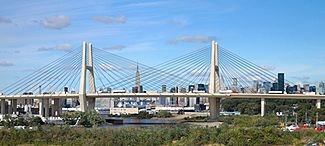
A picture showing what the new bridges would look like when finished.
|
|
| Coordinates | 40°43′40″N 73°55′45″W / 40.7277°N 73.9291°W |
| Carries | |
| Crosses | Newtown Creek |
| Locale | Brooklyn and Queens, New York City |
| Maintained by | New York State Department of Transportation |
| Preceded by | Greenpoint Avenue Bridge |
| Followed by | Grand Street Bridge |
| Characteristics | |
| Design | Cable-stayed bridge |
| Longest span | 1,001 feet (305 m) |
| Clearance below | 90 feet (27 m) |
| History | |
| Opened | April 27, 2017 (eastbound) August 29, 2019 (westbound) |
The 1939 bridge was built to handle about 10,000 cars each day. But by the 1990s, it was carrying 18 times that many cars! It also wasn't built to modern highway standards. For example, it didn't have drainage pipes or shoulders (the side areas for emergencies). Because of this, the bridge was getting old and often had very bad traffic jams.
After a study in 1994–1995, officials decided that a new bridge was needed. This new bridge would cost about $100 million and would have more lanes. It would help ease the traffic problems.
Designing and Building the Eastbound Bridge
In 2009, the plan was set to replace the old 1939 bridge. The new design would include a five-lane eastbound bridge, a four-lane westbound bridge, and a path for bikes and walkers. Several bridge designs were looked at, including a cable-stayed bridge. This design was chosen after people gave their opinions. The new Kosciuszko Bridge is the first major new bridge in New York City since the Verrazano-Narrows Bridge was finished in 1964.
Construction was supposed to start in 2013 but was delayed to 2014. In April 2014, about 140 trees were removed near the bridge to prepare for building. Officials said that twice as many trees would be planted once the bridge was done.
On May 23, 2014, a large contract worth $554.77 million was given to a team of companies. This contract was for building the eastbound bridge and taking down the old one. It was the biggest single contract ever given by the New York State Department of Transportation. The new bridges were built because the Kosciuszko Bridge was known for terrible traffic. The New York Times newspaper called it "perhaps the city's most notorious [bridge]." The new bridges were expected to cut traffic delays by up to 65% during busy times. They also provide a new way for people to walk or bike between Brooklyn and Queens.
Work on the eastbound bridge began on December 4, 2014. By August 2015, the two tall towers, called pylons, for the eastbound bridge were being built. These pylons are about 287 feet (87 m)*. They stand on strong foundations that go deep into the ground. After the pylons were finished, a large steel and concrete section was built between them. Other sections of the bridge deck were then built outwards from this center part. Each section is held up by two cables. In total, the bridge deck is 1,001 feet (305 m)* and supported by 56 cables. A heavy 4,000-short-ton (3,600-long-ton) counterweight was built under one side of the bridge. This was because one side was longer and heavier than the other. The new bridge was built to last for 100 years.
The new eastbound bridge opened earlier than planned on April 27, 2017. Governor Andrew Cuomo attended the opening ceremony. This bridge is one of the first in the city to have a special lighting system. This system allows the bridge to put on light shows as a tourist attraction. At first, five of the six lanes of traffic moved to the new bridge. One lane of westbound traffic still used the old bridge for a short time. The new bridge kept the same name as the original.
Taking Down the Old Bridge and Building the Westbound Bridge
Part of the old bridge was taken down using a controlled explosion in October 2017. This method saved many months compared to taking the bridge apart piece by piece. This allowed work on the new westbound bridge to start sooner. The new westbound span and the bike/pedestrian path would add more traffic capacity.
The main part of the old bridge was carefully lowered onto two barges. On July 26, 2017, this main section was shipped to New Jersey to be recycled. This was the first step in taking down the old bridge. The parts of the bridge leading up to the main span were then taken down on October 1, 2017. This was done with 944 small explosive charges. It was the biggest explosive demolition of a bridge in New York City. The state planned to recycle all the steel from these parts, which weighed a lot.
After the old bridge was gone, construction began on the westbound bridge. Work moved quickly. In May 2019, Governor Cuomo announced that the westbound bridge would open by September. The opening date was later set for August 29, 2019. The westbound bridge opened on that date, and people could walk or bike across it the day before. As part of building the westbound bridge, a 7-acre (2.8 ha) park will be built under the Brooklyn side of the bridge. This park, called "Under the K," will have different areas, including paths, a multi-use space, a performance area, and a waterfront seating area.


